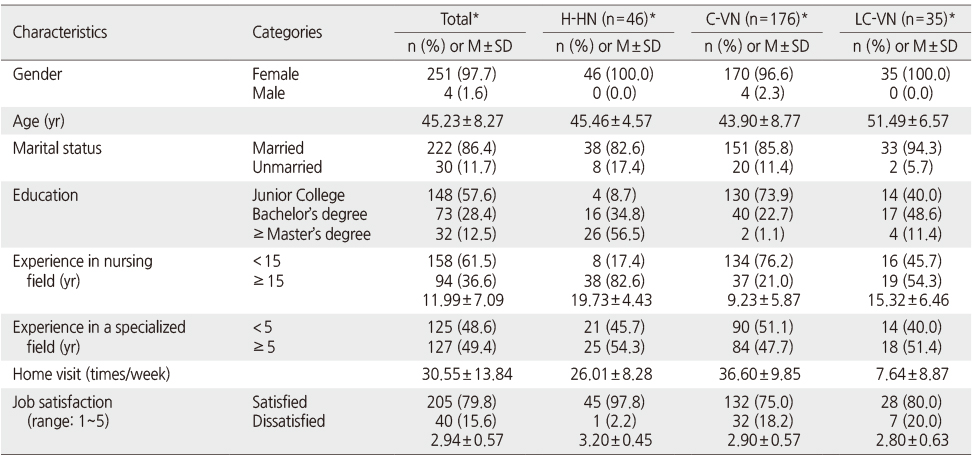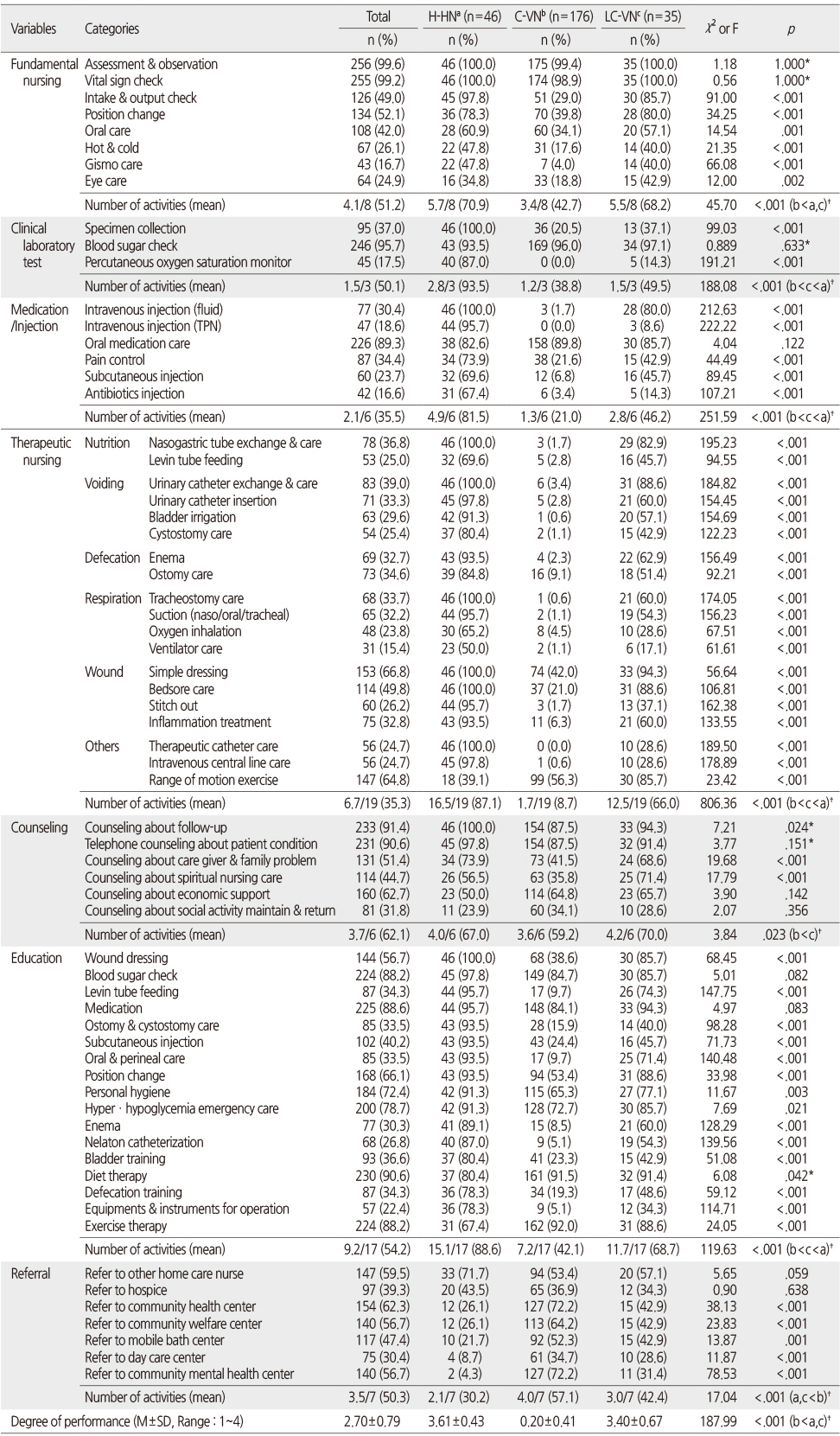Articles
- Page Path
- HOME > J Korean Acad Nurs > Volume 45(5); 2015 > Article
-
Original Article
- Current Status of Home Visit Programs: Activities and Barriers of Home Care Nursing Services
- Eui Geum Oh, Hyun Joo Lee, Yukyung Kim, Ji Hyun Sung, Young-Su Park, Jae Yong Yoo, Soohee Woo
-
Journal of Korean Academy of Nursing 2015;45(5):742-751.
DOI: https://doi.org/10.4040/jkan.2015.45.5.742
Published online: October 30, 2015
1College of Nursing·Mo-Im Kim Nursing Research Institute, Yonsei University, Seoul, Korea.
2College of Nursing, Graduate School, Yonsei University, Seoul, Korea.
3Korea Armed Forces Nursing Academy, Daejeon, Korea.
4The Institute for Comparative Effectiveness Research in Nursing·College of Nursing, Konyang University, Daejeon, Korea.
5Department of Nursing, Kyung-In Women's University, Incheon, Korea.
- Address reprint requests to: Oh, Eui Geum. College of Nursing·Mo-Im Kim Nursing Research Institute, Yonsei University, 50 Yonsei-ro, Seodaemun-gu, Seoul 03722, Korea. Tel: +82-2-2228-3256, Fax: +82-2-392-5440, euigeum@yuhs.ac
© 2015 Korean Society of Nursing Science
This is an Open Access article distributed under the terms of the Creative Commons Attribution NoDerivs License. (http://creativecommons.org/licenses/by-nd/4.0/) If the original work is properly cited and retained without any modification or reproduction, it can be used and re-distributed in any format and medium.
Abstract
-
Purpose
- The purpose of this study was to examine the current status of home care nursing services provided by community health nurses and to identify barriers to the services.
-
Methods
- A cross-sectional survey was conducted with three types of community health care nurses. Participants were 257 nurses, 46 of whom were hospital based home care nurses, 176 were community based visiting nurses, and 35 were long term care insurance based visiting nurses. A structured questionnaire on 7 domains of home care nursing services with a 4-point Likert scale was used to measure activities and barriers to care. Data were analyzed using SPSS WIN 21.0 program.
-
Results
- Hospital based home care nurses showed a high level of service performance activity in the domain of clinical laboratory tests, medications and injections, therapeutic nursing, and education. Community based visiting nurses had a high level of service performance in the reference domain. Long term care insurance based visiting nurses showed a high level of performance in the service domains of fundamental nursing and counseling.
-
Conclusion
- The results show that although health care service provided by the three types of community health nurse overlapped, the focus of the service is differentiated. Therefore, these results suggest that existing home care services will need to be utilized efficiently in the development of a new nursing care service for patients living in the community after hospital discharge.
This research was supported by a grant of the Korea Health Technology R&D Project through the Korea Health Industry Development Institute (KHIDI), funded by the Ministry of Health & Welfare, Republic of Korea (grant number: HI13C0775).
- 1. Korea Institute for Health and Social Affairs. 2013 patient survey [Internet]. Seoul, Ministry of Health & Welfare, Korea Institute for Health and Social Affairs. 2013;cited 2014 April 22. Available from: http://stat.mw.go.kr/front/statData/publicationView.jsp?bbsSeq=11&nttSeq=21200&menuId=45
- 2. Holland DE, Mistiaen P, Bowles KH. Problems and unmet needs of patients discharged "home to self-care". Prof Case Manag. 2011;16(5):240–250.ArticlePubMed
- 3. Holland DE, Knafl GJ, Bowles KH. Targeting hospitalised patients for early discharge planning intervention. J Clin Nurs. 2013;22(19-20):2696–2703. ArticlePubMed
- 4. Moon OR, Kang SH, Lee EP, Jwa YK, Lee HS. An analysis on the characteristics of high cost patients in the regional medical insurance program. Korean J Health Policy Adm. 1983;3(1):53–83.
- 5. Kim KA, Shine EK, Baek SJ, Choi YS, Jung KT. A study on catastrophic user-paid expenditure attributes for patient in national health insurance. Korean J Health Econ Policy. 2011;17(3):75–99.
- 6. Askren-Gonzalez A, Frater J. Case management programs for hospital readmission prevention. Prof Case Manag. 2012;17(5):219–226. ArticlePubMed
- 7. Lee E, Yu SH, Lee HJ, Kim S. Factors associated with unplanned hospital readmission. Korean J Hosp Manage. 2010;15(4):125–142.
- 8. Lee JH, Kim YM, Kang SH. A study patient management for both planned and unplanned readmission in a medium-size hospital. Health Serv Manag Rev. 2008;2(1):11–17.
- 9. Oh HJ, Yu SH. A case-control study of unexpected readmission in a university hospital. Korean J Prev Med. 1999;32(3):289–296.
- 10. Kassin MT, Owen RM, Perez SD, Leeds I, Cox JC, Schnier K, et al. Risk factors for 30-day hospital readmission among general surgery patients. J Am Coll Surg. 2012;215(3):322–330. ArticlePubMedPMC
- 11. Toronto Central Community Care Access Centre. 50 Years of caring for Toronto [Internet]. Toronto, CA, Author. 2014;cited 2014 September 22. Available from: http://healthcareathome.ca/torontocentral/en/performance/Documents/TOCCAC-AnnualReport-FullProof-12-HighRes.pdf#sthash.0gUhWxEh.dpuf
- 12. Australian Government, Department of Health and Ageing. Transition care program 2011 [Internet]. Canberra, AU, Commonwealth of Australia Year. 2011;cited 2014 August 7. Available from: https://bendigohealth.mhr.com.au/Upload%5CPDs%5C51495-TransCareProgGuidelines2011.pdf
- 13. Balaban RB, Weissman JS, Samuel PA, Woolhandler S. Redefining and redesigning hospital discharge to enhance patient care: A randomized controlled study. J Gen Intern Med. 2008;23(8):1228–1233. ArticlePubMedPMCPDF
- 14. Jack BW, Chetty VK, Anthony D, Greenwald JL, Sanchez GM, Johnson AE, et al. A reengineered hospital discharge program to decrease rehospitalization: A randomized trial. Ann Intern Med. 2009;150(3):178–187.ArticlePubMedPMC
- 15. Tsuchihashi-Makaya M, Matsuo H, Kakinoki S, Takechi S, Kinugawa S, Tsutsui H. Home-based disease management program to improve psychological status in patients with heart failure in Japan. Circ J. 2013;77(4):926–933.ArticlePubMed
- 16. Shin HS, Oh JJ. Case management for medical aid beneficiaries in Korea: Findings from case-control study. Asian Nurs Res. 2014;8(4):274–281. Article
- 17. Ministry of Health & Welfare. Hospital based home care nursing program guidelines. Seoul, Author. 2010;cited 2014 December 10. Available from: http://www.mw.go.kr/front_new/al/sal0101vw.jsp?PAR_MENU_ID=04&MENU_ID=040101&CONT_SEQ= 237214&page=1
- 18. Ministry of Health & Welfare, Korea Health Promotion Foundation. 2013 Integrated community health promotion program [Internet]. Seoul, Author. 2013;cited 2013 December 10. Available from: http://www.mw.go.kr/front_new/jb/sjb0601vw.jsp?PAR_MENU_ID=03&MENU_ID=03160501&CONT_SEQ=286506&page=1
- 19. Ministry of Health & Welfare. Main contents of the act of long-term care insurance for the elderly [Internet]. Seoul, Author. 2013;cited 2013 August 6. Available from: http://www.mw.go.kr/front_new/jb/sjb0403vw.jsp
- 20. Lee SH, Lim JY. Strategies of home health care services linkages in Korea based on Delphi technique. J Korea Contents Assoc. 2012;12(12):282–290.Article
- 21. Lim JY, Kim EJ, Choi KW, Lee JS, Noh WJ. Analysis of barriers and activating factors of visiting nursing in long-term care insurance. J Korea Contents Assoc. 2012;12(8):283–299. Article
- 22. Chin YR, Lee I, Chang HS. Analysis of the effects and nursing intervention of home health care in public health centers. J Korean Community Nurs. 2004;15(3):353–364.
- 23. Korea Health Industry Development Institute, Korean Health Promotion Foundation. The role and function of home healthcare based on the public health centers, hospitals and long-term care insurance [Internet]. Seoul, Ministry of Health & Welfare. 2007;cited 2014 July 14. Available from: http://www.khidi.or.kr/fileDownload?titleId=118694&fileId=1
- 24. Boter H. Multicenter randomized controlled trial of an outreach nursing support program for recently discharged stroke patients. Stroke. 2004;35(12):2867–2872. ArticlePubMed
- 25. Harrison JD, Young JM, Solomon MJ, Butow PN, Secomb R, Masya L. Randomized pilot evaluation of the supportive care intervention "CONNECT" for people following surgery for colorectal cancer. Dis Colon Rectum. 2011;54(5):622–631. ArticlePubMed
- 26. Lindpaintner LS, Gasser JT, Schramm MS, Cina-Tschumi B, Müller B, Beer JH. Discharge intervention pilot improves satisfaction for patients and professionals. Eur J Intern Med. 2013;24(8):756–762. ArticlePubMed
REFERENCES
Figure & Data
REFERENCES
Citations

- Medication adherence and related factors among older adults with type 2 diabetes who use home health care
Doyeon Lim, Kyungmi Woo
Geriatric Nursing.2025; 61: 270. CrossRef - Using an internet-based platform to provide online and offline healthcare services for discharged patients
Lei Cui, Zirong Tong, Rong Wang, Xiaoping Fang, Longxiu Liu
BMC Nursing.2024;[Epub] CrossRef - A Model for Improving Public Health Service Accessibility in the Small Living Zone
Young Ran Han, Ok Kyung Ham, Hye Young Choi, Ji Sook An, Ji Sook An
Journal of Korean Public Health Nursing.2024; 38(3): 316. CrossRef - Development and evaluation of a problem‐based learning simulation module for home‐visit nursing
Eunjoo Kim, Ju Young Yoon, Kyungmi Woo, Aeri Kim, Hyori Kim, Juna Lee
Public Health Nursing.2023; 40(6): 857. CrossRef - Barriers to clinical nurse participation in the internet-based home visiting program: a qualitative study
Jiahao Yu, Jianyuan Huang, Chunlei Li, Yongmei Zhuang
BMC Nursing.2023;[Epub] CrossRef - Performance Evaluation of China's Basic Pension Insurance Based on a Three‐Stage Superefficient SBM‐DEA Model
Zexing Xue, Zhengping Ma, Chi Keung Lau
Discrete Dynamics in Nature and Society.2022;[Epub] CrossRef - Critical Thinking Disposition, Job Competency, and Educational Needs of Home Visiting Nurses in the Long-term Care Insurance
Keunyoung Shin, Sujin Shin
Journal of Korean Gerontological Nursing.2021; 23(1): 54. CrossRef - Examination of the Educational Needs of Home Visit Nurses: A Cross-Sectional Descriptive Study
Kyuri Lee, Dukyoo Jung
International Journal of Environmental Research and Public Health.2021; 18(5): 2319. CrossRef - Barriers to accessing internet-based home Care for Older Patients: a qualitative study
Baosheng Zhao, Xiaoman Zhang, Rendong Huang, Mo Yi, Xiaofei Dong, Zhenxiang Li
BMC Geriatrics.2021;[Epub] CrossRef - A SBM-DEA based performance evaluation and optimization for social organizations participating in community and home-based elderly care services
Qiuhu Shao, Jingfeng Yuan, Jin Lin, Wei Huang, Junwei Ma, Hongxing Ding, Majid Soleimani-damaneh
PLOS ONE.2021; 16(3): e0248474. CrossRef - Difficulties and Coping Experienced by Advanced Practice Nurses in Home Health Nursing Field
Moon-Sook Hwang, Hak Young Park, Soo Jung Chang
Journal of Korean Academy of Community Health Nursing.2020; 31(2): 143. CrossRef - Perceptions of Adequacy and Job Performance of Nurse Assistant Nursing Jobs according to Registered Nurses and Nurse Assistants in Geriatric Hospitals, and Caregivers
Myung Hee Cho, Kye Ha Kim
Journal of Korean Academy of Nursing Administration.2016; 22(4): 384. CrossRef
Characteristics of Participants (N=257)
*Nonresponses were excluded; H-HN=Hospital based home care nurse; C-VN=Community based visiting nurse; LC-VN=Long-term care insurance based visiting nurse.
Status of Home Care Nursing Service (N=257)
*Fisher's exact test; †Scheffé test; H-HN=Hospital based home care nurse; C-VN=Community based visiting nurse; LC-VN=Long-term care insurance based visiting nurse; TPN=Total parenteral nutrition.
*Nonresponses were excluded; H-HN=Hospital based home care nurse; C-VN=Community based visiting nurse; LC-VN=Long-term care insurance based visiting nurse.
*Fisher's exact test; †Scheffé test; H-HN=Hospital based home care nurse; C-VN=Community based visiting nurse; LC-VN=Long-term care insurance based visiting nurse; TPN=Total parenteral nutrition.
 KSNS
KSNS
 E-SUBMISSION
E-SUBMISSION


 Cite
Cite

